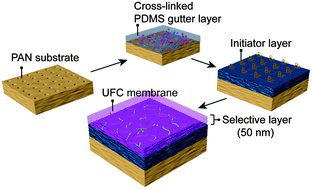A novel cross-linked nano-coating for carbon dioxide capture†
Abstract
Ultra-thin (∼100 nm) films with uniform thicknesses can facilitate high CO2 permeation and are of potential technological significance for CO2 capture. Among many approaches for obtaining such materials, the recently developed continuous assembly of polymers (CAP) technology provides a robust process, allowing for the production of defect-free, cross-linked and surface-confined thin films with nanometer scale precision. Through utilization of this nanotechnology, we have constructed composite membranes containing cross-linked ultra-thin surface films. The membrane materials formed exhibited significantly high permeances as well as excellent gas separation selectivity.


 Please wait while we load your content...
Please wait while we load your content...